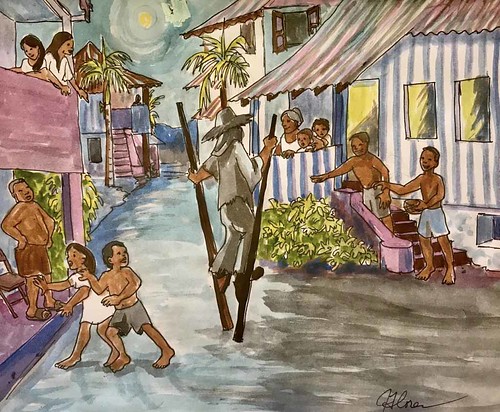Christmas is an important holiday in the Mariana Islands, filled with activities that celebrate Christ’s birth. Many families have their own traditions they participate in every year. It is a time for exchanging presents, gathering at church, eating at family fiestas, praying the nobena and being more generous with the community. A less well-known tradition, though, was Burego’.
Burego’ was a joyful CHamoru/Chamorro Christmas celebration in the Mariana Islands. Young people, but primarily teenagers, masqueraded and went house-to-house in their costumes. The fun of burego’ was guessing the masqueraders’ identity and teasing them about their costumes.
Examples of costumes included taotaomo’na in white sheets with black smudges on their faces, adolescent girls dressed as lancheras (ranchers), adolescent boys dressed in mestizas or muumuu’s, teenagers in masks, gunny sacks, fake mustaches, sombreros and threatening burego’s on stilts. Others were dressed as the Holy Family of Joseph and Mary, with Mary carrying a doll representing baby Jesus.
At each house, the residents shared food with the masqueraders, especially boñelus dagu, which the young people ate as they continued moving from house-to-house in their neighborhood. In the village of Humåtak, Guam, the masquerading teenagers visited houses to collect a whole plate of fiesta food, and then afterwards, went to Midnight Mass. After mass they sat in a circle near the church and ate the food they had collected.
When asked about what they remember about this tradition, almost everyone agreed that burego’ was celebrated on Christmas Eve, but priest and historian Pale’ Eric Forbes found that, on Saipan, it may have been during the Christmas season but not necessarily on Christmas Eve. In Santa Rita, a village transplanted from Sumay, burego’ was celebrated on Christmas Eve, New Year’s Eve, and the Feast of Three Kings, but the biggest celebration, by far, was on Christmas Eve.
Burego’ was a Spanish custom adopted in the Marianas in the 1700s. The Spanish appropriated this custom from the Romans. The roots of burego’ in Spain came from the Roman custom of saturnalia. Saturnalia was a December solstice festival for Saturn, the Roman god of time, wealth, agriculture, and renewal.
In Chamorro, the word burego’ means “incognito, a person in disguise; a clown.” Burego’ was meant to be fun and for young people to have a good time. The Chamorros demonstrated their agency by incorporating their indigenous December solstice customs into the adoption of burego’. The solstice in Guam is the harvest time for dagu, and the sharing of food is a core Chamorro value. Indeed, the indigenous custom of sharing food, and especially dagu, is still practiced.
Few people today know of or remember the burego’ custom. In the southern villages of Guåhan/Guam, we can only speculate why the burego’ custom of masquerading on Christmas Eve seems to have been abandoned by the 1960s. Another puzzle is, why there were no reports of burego’ being practiced in northern Guam?
By Lawrence J. Cunningham and Cheryl N. Cunningham
Editor’s note: Paper presented at the 5th Marianas History Conference, 19 – 28 February 2021. Presented here with permission from the author. The authors thank Manuel Diego Afaisen, Margaret Leon Guerrero Blas, Attorney Omaira Brunnel-Perry, Doris Cruz, Professor Marjorie Driver, Alejo Perez Flores, Dr. Judy S. Flores, Pale’ Eric E. Forbes, Juan Guzman, Aurora Sablan Lowe, Dr. Carlos Madrid, Professor Rosa Salas Palomo, and Dolores Flores Paulino for their kind assistance in completing this entry.


